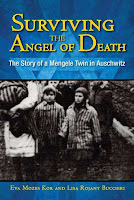
by Eva Mozes Kor and Lisa Rojany Buccieri
Eva grew up in Romania in a family that had a true community outreach. Her mother was there to help anyone in need. Her father was a hardworking farmer, known for his reputation of honesty. Her sisters did well in school. And Miriam, her twin, would eventually be the one to save her life.
In the early 10940’s Eva and Miriam’s parents began hearing about the trouble between the Germans and Jews, but didn’t think it would ever reach their small rural farming community. But it did, and on her 10th birthday, they were marched to the rail station and taken to Auschwitz, where both tragedy and miracles worked and lived together.
Josef Mengele was waiting when the trains arrived and with a twitch of his cane, he made choices that killed thousands at people at a time. But his eye was trained on Eva and Miriam because they were twins. And he needed them for his experiments…
This is the memoir of a woman who tells her story of survival and torture and ultimate redemption through the eyes of her 10 year old self. Thousands of children were called Mengele’s twins, but not many survived the excruciating experiments he performed on them. She and her sister were some of those few.
What a powerful read for young adults. Teens know about the Holocaust, but this is a book that will take them inside a different part of Auschwitz and a story that hardly gets told. The voice in this book carries the lilt of an woman re-living those years and how it changed her life completely. Filled with haunting photographs, her story mixes well with them to bring the reader into the horror of the barracks and living conditions children were forced to live in from the moment they were separated from their family and lives. The appealing aspect of this non-fiction book is that the reader sees the suffering of concentration camp life through the filter of a child’s eyes, not that of an adult, which can be much more graphic in description. I only wished there was an appendix of sources, both hardcopy and digital to go along with Eva’s story…
No comments:
Post a Comment